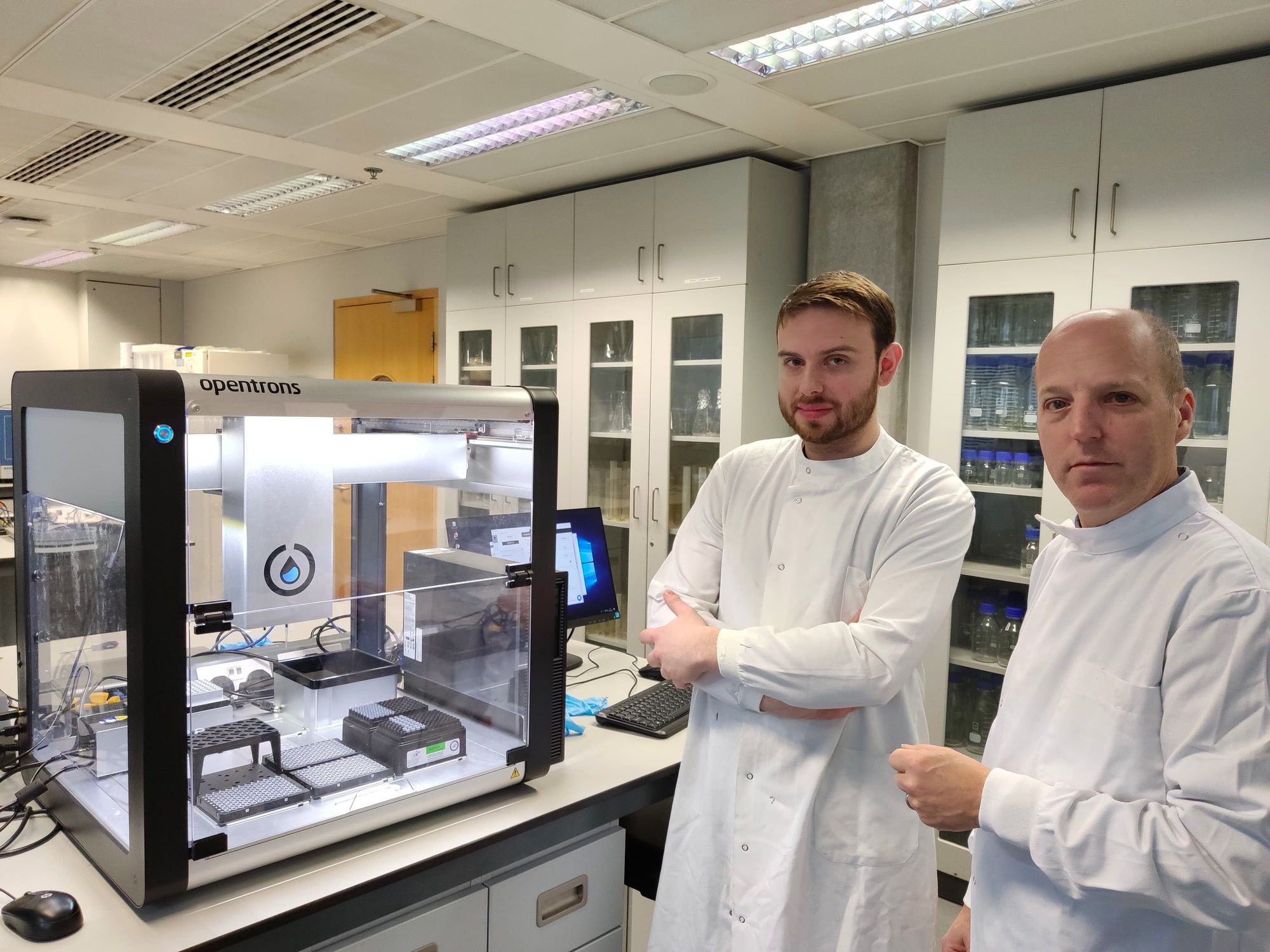
Scientists at Imperial College London use BASIC and an Opentrons OT-2 liquid handling robot to automatically assemble DNA constructs for synthetic biology applications.
To explore biology more deeply and quickly, scientists need easy and efficient methods to make DNA constructs, which are artificially created segments of nucleic acids. “We’re trying to apply engineering approaches to biology so we can more efficiently develop new biological systems for useful purposes,” says Geoff Baldwin, co-director of the Imperial College Centre for Synthetic Biology. “Historically, making a new DNA construct was slow—taking two to three months to design and build—and it probably didn’t work.” Baldwin and his colleagues—Marko Storch, head of automation at the London Biofoundry and postdoctoral researcher Matt Haines—developed tools to make it easier, faster and more reliable to create a DNA construct.(1)

(From left to right) Matt Haines and Geoff Baldwin in their lab with an OT-2 liquid handling lab robot. CREDIT: Imperial College
Some improved parts already existed. “Today, we have much better tools,” says Baldwin. “The same way that you build IKEA furniture, you can build a biological system from standard parts, which is a more efficient way.”
“The same way that you build IKEA furniture, you can build a biological system from standard parts, which is a more efficient way.”
Getting to the BASICs
Before automating the process, Storch, Baldwin and other colleagues developed BASIC, which stands for: Biopart Assembly Standard for Idempotent Cloning.(2) The scientists wrote that BASIC “exploits the principle of orthogonal linker-based DNA assembly to define a new physical standard for DNA parts.” In other words, they created a standardized kit that is easy to use, but which can create complex designs.
To some extent, BASIC drives researchers to think in new ways about building DNA constructs. “It provides fantastic operability,” Baldwin says. “Once you embrace the standardized approach, there’s greater freedom for thinking—you no longer have to think about the details of individual sequences, overlaps, PCR and so on.”
So, with BASIC, scientists move from putting a large amount of attention on how to build DNA to thinking about the behavior of a system. Plus, BASIC generates very accurate DNA builds. “You have confidence that the synthetic DNA is what you want,” Baldwin says.
With BASIC, scientists move from putting a large amount of attention on how to build DNA to thinking about the behavior of a system – while generating very accurate DNA builds.
In addition to improvements in accuracy, BASIC simplifies the process of building DNA. “It provides methods that are simpler to implement,” Storch says. “You get the parts and linkers that work out of the box, and there’s less need for troubleshooting.” Then, the scientist only needs to know how to combine part-linker-part-linker and so on to build a construct.
Baldwin compares it to the evolution in computers. Decades ago, someone building a computer needed to know about transistors and logic gates. “Today, you don’t have to worry about the physics of computing, because you can just take the components out of the box,” he says. “Similarly, BASIC lets users enjoy a similar abstraction hierarchy for DNA.”
Still, making the most of BASIC requires lab automation.
Adding Opentrons
“When Opentrons came out with the OT-2, the philosophy of open-source really resonated with how we think about linker-based DNA assembly,” Storch says. “The module for magnetic beads and a temperature deck created an entry-level robot that came with the abilities that you would like.”
So, the open-source BASIC technology—freely available on GitHub—fits just right with an open-source liquid handling robot. “We believe the value should be in what you build, not how you build it,” Baldwin says. That spawned DNA-BOT, which is an OT-2 running BASIC.

(From left to right) Matt Haines and Geoff Baldwin contemplate their DNA-Bot. CREDIT: Imperial College
When asked about DNA-BOT’s benefits, Haines says, “One is the price compared to other platforms.” Then, he also reiterates the efficiency and accuracy of the method. “We obtained constructs in every case for our 88 assemblies while achieving high accuracy,” he says. “That doesn’t always happen, particularly with non-standardized methods”
At the Imperial College Centre for Synthetic Biology, Baldwin and his colleagues set up a lab of six DNA-BOTs. “We’re trying to see if masters students can build constructs with this platform,” Storch says.

Graduate students setting up the Imperial College Biofoundry. CREDIT: Imperial College London
Regardless of how the trial run goes with those students, Baldwin’s team already knows that the DNA-BOT changes the playing field. “The design space that we could explore is hundreds, maybe thousands of DNA constructs,” Baldwin says, “and it can quickly become tens of thousands.”
As Haines emphasizes, “There’s lots of variability to explore.”
Enhancing applications
Baldwin’s team sees lots more work to do. Already, they see the DNA-BOT working in a range of applications, including studying existing biosynthetic pathways and creating new ones to build hard-to-make compounds.
The team continues to develop and fine tune the DNA-BOT, and they plan to integrate the newly launched Opentrons Thermocycler. “We want to build an ecosystem,” Baldwin says. “That will create a landscape of DNA parts and processes that will enhance what people can do.” When affordable, easy-to-use and effective automation gets combined with an advanced synthetic-biology toolbox, the entire world of building DNA constructs changes and almost anyone can explore it.
References